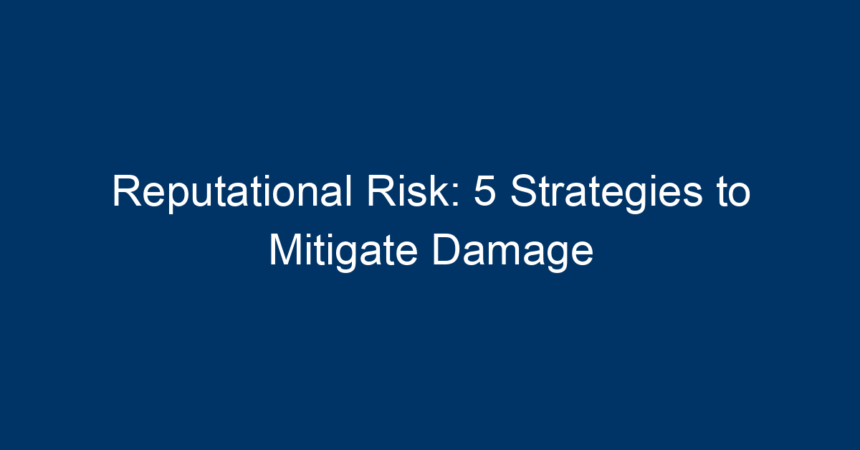In today’s interconnected digital landscape, companies are more vulnerable than ever to reputational risk. One tweet, a blog post, or a viral video can significantly impact a business’s public perception. As consumers become increasingly aware and vocal, sustaining a positive reputation is critical not just for customer trust, but also for financial stability. This article dives deep into reputational risk and offers five effective strategies to mitigate its potential damage.
Understanding Reputational Risk
Reputational risk refers to the potential loss that a business could face due to negative publicity or public perception. This can stem from various factors, including:
- Social Media Outbursts: Negative comments or reviews can spiral out of control quickly.
- Product Failures: Poor quality or harmful products can erode customer trust.
- Ethical Missteps: Company actions that contradict societal expectations can lead to significant backlash.
The consequences of reputational risk can be damaging, leading to loss of customers, decreased sales, and diminished brand equity. Therefore, preparedness is key.
Strategy 1: Establish a Strong Brand Identity
Cultivate Trust and Transparency
The first step in mitigating reputational risk is to establish a strong, positive brand identity that resonates with your target audience. This involves:
-
Defining Your Values: Clearly articulate what your brand stands for, including your missions, values, and beliefs. This helps create a loyal customer base that trusts your actions.
- Transparent Communication: Open and honest communication is vital. Whether it’s responding to customer questions or addressing issues, being transparent builds credibility.
Build a Positive Online Presence
Engage actively on social media and ensure your website reflects your brand ethos. Regularly post quality content that showcases your brand’s strengths and values. High-quality online presence reduces the chances of negative information overshadowing your achievements.
Strategy 2: Monitor Your Online Reputation
Utilize Monitoring Tools
To effectively manage reputational risk, monitoring your online presence is crucial. Use digital tools like Google Alerts, Hootsuite, or Brand24 to track mentions of your company across various platforms. By being aware of what is being said, you can act quickly to address potential issues.
Conduct Regular Reputation Audits
Schedule regular audits of your brand’s reputation. Here’s how you can do it:
- Customer Surveys: Gather feedback regularly to assess sentiments about your products and services.
- Social Listening: Pay attention to what customers and critics say about your brand on social media.
By keeping a pulse on your reputation, you can identify problems before they escalate.
Strategy 3: Foster Strong Customer Relationships
Engage Back with Your Customers
Building strong relationships is key to minimizing reputational risk. Interaction with customers can encourage loyalty and positive word-of-mouth. Here are some tips:
- Personalize Your Approach: Use customer data to tailor experiences and products.
- Encourage Feedback: Create channels for customers to voice their opinions, and be responsive to both positive and negative feedback.
Empower Your Employees
Your employees are your best ambassadors. By ensuring they are aligned with company values and are well-informed, you create a more confident and optimistic workforce, which radiates to customers.
Strategy 4: Create a Crisis Management Plan
Be Prepared for the Unexpected
No matter how well you manage your reputation, incidents can occur. A well-defined crisis management plan is crucial to handle unforeseen circumstances effectively. Here’s what to include:
-
Define Roles and Responsibilities: Identify who will handle communication, media inquiries, and internal messaging during a crisis.
- Develop Communication Templates: Having pre-prepared statements can save time when addressing the public or stakeholders.
Regular Training and Simulations
Conduct training sessions and crisis simulations with your team. This ensures everyone knows their roles during a crisis and can respond efficiently, thereby minimizing reputational damage.
Strategy 5: Measure and Evaluate Your Efforts
Analyze Key Performance Indicators (KPIs)
Systematic evaluation provides insights into your efforts and further strengthens your reputation management strategy. Key KPIs to assess include:
- Customer Satisfaction Scores: Engagement levels can indicate how customers perceive your brand.
- Social Media Engagement Rates: High engagement levels often correlate with positive sentiment.
Continuous Improvement
Using the data collected from your KPIs, iterate on your strategies. Adapt your approach based on what works and what doesn’t to stay ahead of potential reputational risks.
Conclusion: Proactive Reputation Management
In an age where reputational risk looms large, businesses must take proactive steps to safeguard their image. By establishing a strong brand identity, monitoring your online presence, fostering customer relationships, creating a crisis management plan, and measuring your efforts, you can effectively minimize potential damage to your reputation.
Remember: reputation is built over years but can be tarnished in moments. Taking action today will safeguard your brand’s future and ensure long-term success. Stay vigilant and committed to maintaining a positive public perception, and your efforts will pay off in both customer loyalty and market standing.




